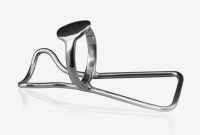Triggering

A nodule or inflammation and “thickening” on the flexor tendon may cause irregular movement of the finger. The finger feels “locked” in the bent position and when it is straightened, there is a painful snap. Repetitive activities aggravate this condition and pain starts limiting function. Splints may be used to limit bending of the finger for several weeks to allow the inflammation to diminish. This can be a reoccurring problem with inflammatory diseases such as rheumatoid arthritis.


For Tenosynovitis in the Palm
Use the SilverRing™ Trigger Splint to relieve chronic recurring flexor tenosynovitis in the palm by restricting MCP flexion. This will help avoid clicking or locking of the flexor tendon in the A1-A2 pulley, allowing swelling and inflammation to subside. Open, lightweight and durable, this splint will treat chronic, recurring triggering without the bulk and bothersome straps of other splints. Patients will appreciate both the ease of use and the ability to manage their own therapy conservatively without surgery.
Shop for Trigger Splints >

For Tenosynovitis in the Fingers
Use the SilverRing™ Boutonniere or SilverRing™ Long Boutonniere Splint to restrict flexion of the PIP joint when flexor tendon tenosynovitis occurs in the proximal or middle phalanx.
Shop for Boutonniere Splints >

For Tenosynovitis in the Thumb
Use the SilverRing™ Spiral Splint to block flexion of the IP joint of the thumb. Wear the splint with the center crossing diagonally over the dorsal surface of the IP joint. This is a very comfortable way to restrict flexion of the IP joint and limit irritation of the flexor tendon.
Shop for Spiral Splints >